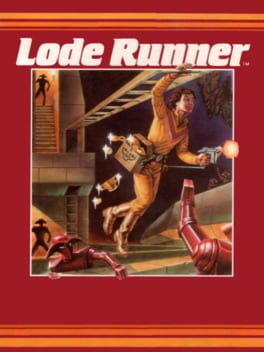In 1982, Doug Smith, then a student at the University of Washington, began developing a game to pass the time. The result, after some trials and tribulations with the publisher Brøderbund, is Lode Runner, published in 1983 for the Apple II. A forerunner in the puzzle platformer genre, the title may have been inspired by BurgerTime (1982), with which it shares the idea of a defenceless protagonist who deals with enemies by clever use of the platforms. Lode Runner thus features a hero who has to collect piles of gold, in a sort of underground network, whose different levels are full of ropes and ladders. Because the protagonist cannot attack, he has to get rid of the enemies either by go around them or by making them fall into holes. Those are created by digging into the various blocks of the levels. Enemies are dispatched if the block respawns while the enemy is still in the hole. Such a system encourages a delicate and prophylactic approach, in order to trap enemies at the right time. It's often a case of 'divide and conquer', so that one only has to deal with one or two enemies at a time: moreover, some situations can be more elegantly resolved by not killing the enemies, but locking them in a particular place, after abusing their pathfinding.
The basic concept is solid, which explains the success of the arcade title, as well as the consequent number of sequels and ports on different consoles and computers. The NES version tries as best it can to translate the arcade concept, but technical limitations have forced some structural modifications. First of all, the levels are vertically contracted, since the NES lacks two lines: this makes the levels marginally easier. Secondly, of the 150 levels available in the arcade, only the first fifty have been ported. Nevertheless, the title retains its level creator. Indeed, as soon as the prototype game was up and running, Smith shared the level editor with the people around him; the story goes that he also shared it with the kids in his neighbourhood to finish the 150 levels required by Brøderbund. As such, the level editor is a pioneer for the NES, since it predates the ones from Excitebike (November 1984) and Mach Rider (1985).
There are a few things that illustrate the antiquity of the title, notably the handling of hitboxes and collisions. For example, it is noticeable that the digging animation is cancelled, if an enemy gets too close to the square being dug, resulting in a quick death. This forces the player to anticipate the arrival of enemies from a distance: the problem is that the NES' horizontal scrolling only works when the avatar is very close to the edge of the screen. As such, it's easy to be surprised by an enemy one didn't know was so close to the protagonist – this is even exacerbated by the respawn of enemies at a random location. The gameplay is still stiff and enemy movement can be sometimes erratic and incomprehensible, especially when the character is one line below them. These problems are not critical and it is possible to adapt to them, but they somewhat pose unnecessary complications. Lode Runner is still an interesting title – if only for its pioneering nature –, never technically bad, but it is hard to see the point of playing this particular version nowadays.
The basic concept is solid, which explains the success of the arcade title, as well as the consequent number of sequels and ports on different consoles and computers. The NES version tries as best it can to translate the arcade concept, but technical limitations have forced some structural modifications. First of all, the levels are vertically contracted, since the NES lacks two lines: this makes the levels marginally easier. Secondly, of the 150 levels available in the arcade, only the first fifty have been ported. Nevertheless, the title retains its level creator. Indeed, as soon as the prototype game was up and running, Smith shared the level editor with the people around him; the story goes that he also shared it with the kids in his neighbourhood to finish the 150 levels required by Brøderbund. As such, the level editor is a pioneer for the NES, since it predates the ones from Excitebike (November 1984) and Mach Rider (1985).
There are a few things that illustrate the antiquity of the title, notably the handling of hitboxes and collisions. For example, it is noticeable that the digging animation is cancelled, if an enemy gets too close to the square being dug, resulting in a quick death. This forces the player to anticipate the arrival of enemies from a distance: the problem is that the NES' horizontal scrolling only works when the avatar is very close to the edge of the screen. As such, it's easy to be surprised by an enemy one didn't know was so close to the protagonist – this is even exacerbated by the respawn of enemies at a random location. The gameplay is still stiff and enemy movement can be sometimes erratic and incomprehensible, especially when the character is one line below them. These problems are not critical and it is possible to adapt to them, but they somewhat pose unnecessary complications. Lode Runner is still an interesting title – if only for its pioneering nature –, never technically bad, but it is hard to see the point of playing this particular version nowadays.
2 Comments
@lpslucasps: It's probably a question of personal preferences? The main issue is that it's an incomplete port (only one third of the levels and some are amputated), but the graphical changes might appeal to some. The AI is also arguably a bit more aggressive in the NES version. As for the arcade version, I don't know at all!

lpslucasps
1 year ago